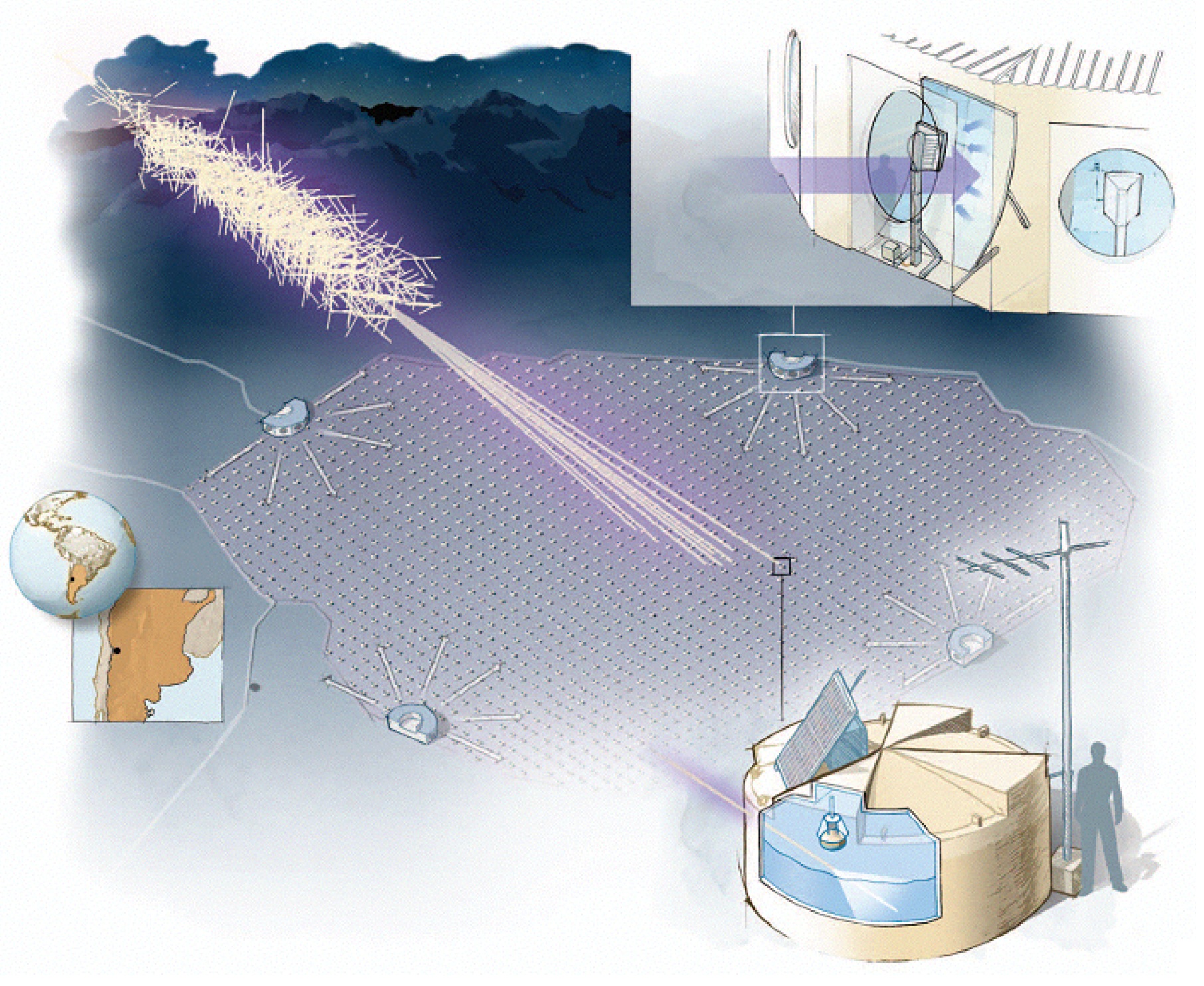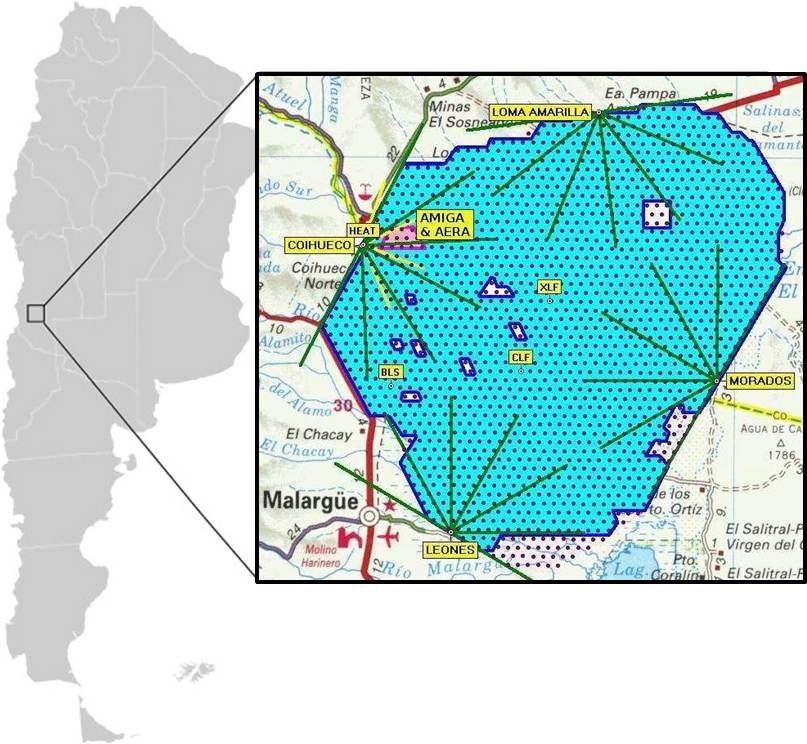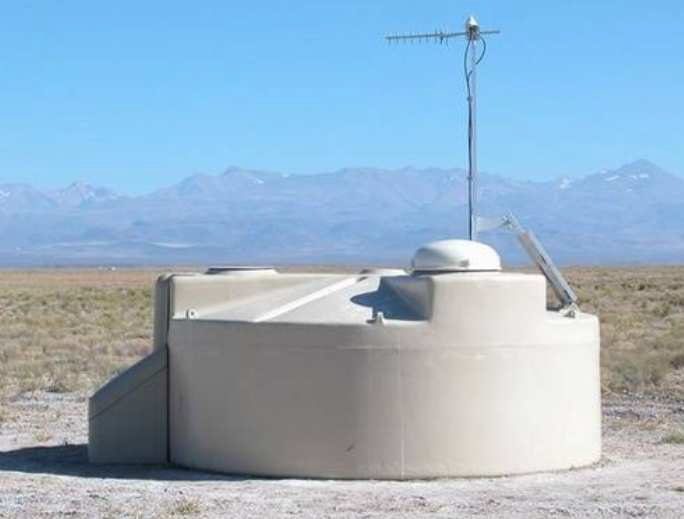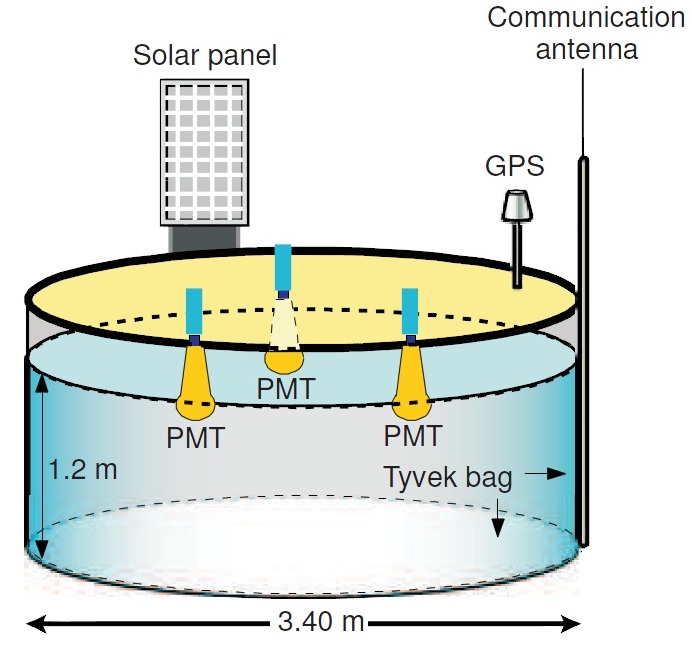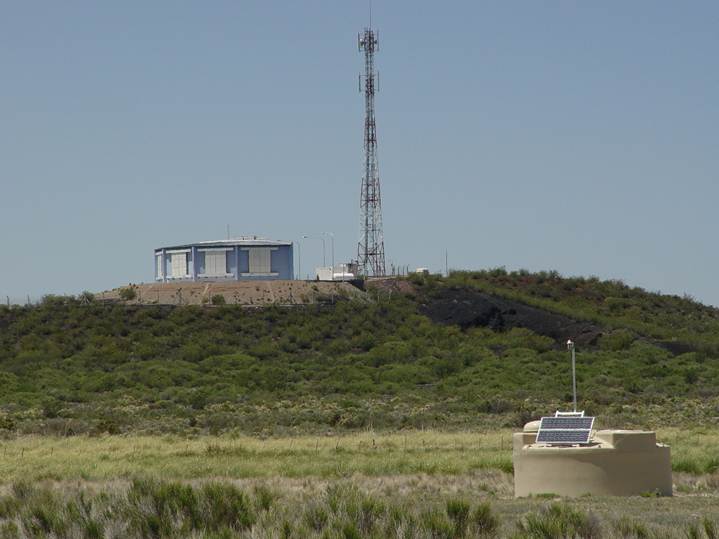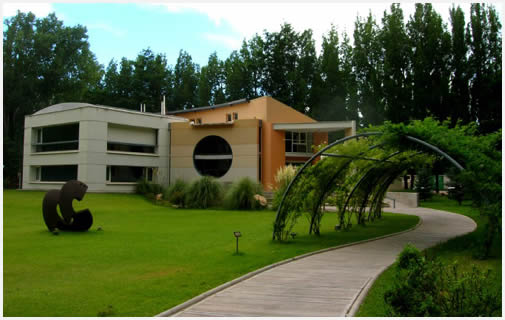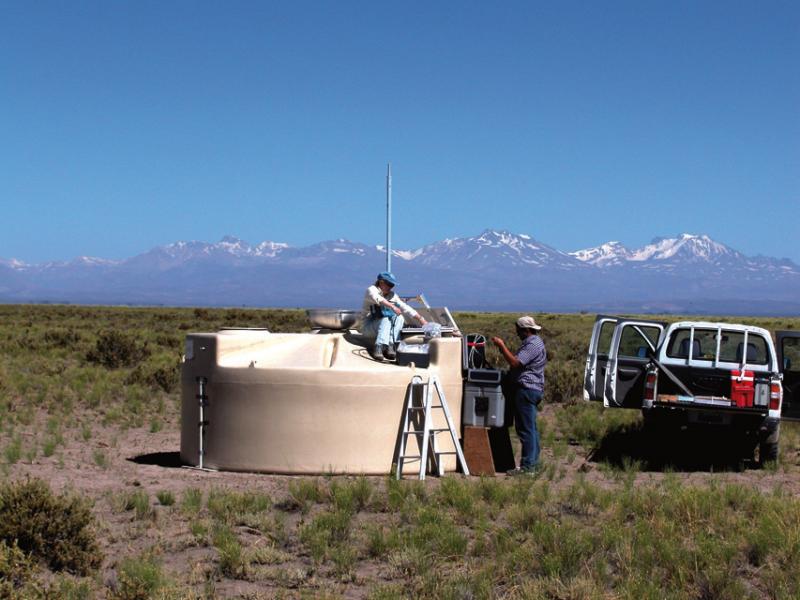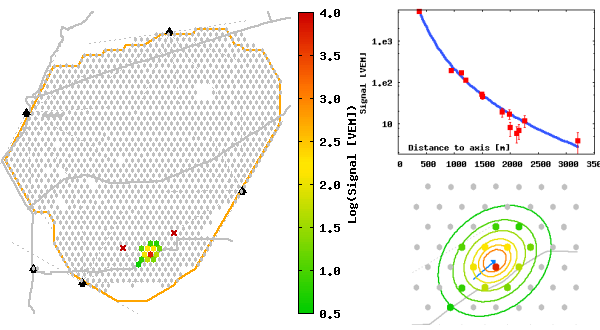João
Home Page
Research > The Pierre Auger Observatory
The Pierre Auger Observatory (PAO), is the largest cosmic ray experiment at the present, It covers an area about 3000km2 (similar size of Rhode Island, or bigger than the Lisbon District). The project was presented to the scientific community in 1992 by James Cronin(laureate with Nobel Prize in 1980) and Alan Watson. The name of the observatory came from the French Physicist that discovered the Extensive Air Shower (1939). Almost 500 physicists from institutions around the world are collaborating to maintain and upgrade the site in Argentina and collect and analyze the measured data. The construction budget was approximately $50 million, being shared in small portions by each 15 participating countries.
The main objective of the experiment is to answer some questions like: what are the origin of the cosmic rays?; What are the cosmic ray composition?; What are the behavior of the hadronic interactions?; study the GZK cutoff and several others. In this section I have include:
The Observatory is located on Pampa Amarilla, next to Mallargue, Province of Mendoza, Argentina (35° South).
The main purpose of Auger is to study the Ultra High Energy Cosmic Rays that hits our atmosphere. We can detect the particles that reach the ground and the emission of light through out the atmosphere, for more information look in Auger Physics . Below, you can see some videos that introduce the Observatory.
Pierre Auger Observatory
Pierre Auger Observatory (long overview)
Tour of the Pierre Auger Observatory with Google Earth, by Alan Watson
Prof Alan Watson - IOP Award winner:
on cosmic rays
on cosmic rays
The SD consists of an array of water Cherenkov detectors, covering about 3000km2. On the border of the ground array, we have four Fluorescence detectors, each with six telescopes (similar to the High Resolution Fly's Eye). The Observatory was completed in May 2008 and began to record data since January 2004, with the parts of experiment that were already operational.
In the right, is represented the configuration of the Pierre Auger Observatory. The red circles corresponds to the 1600 Cherenkov tanks. In the edges we have the 4 FD (Fluorescence Detector) facilities; Loma Amarilla, Coihuenco, Los Leones, and Los Morados. Each FD facility has 6 telescopes, the lines in the image corresponds to the field of view of each telescope. We also have a 5th FD facility called HEAT, alongside with Coihueco.
Surface Detector (SD)
The SD consists of an array of water Cherenkov tanks detector, covering about 3000km2 with 1600 detectors spaced by 1.5 kilometres in a triangular grid. They are located at an altitude of around 1400m (875 g/cm2 in atmospheric depth), with differences between them of ~1%. The ground array is similar to the one in Haverah Park.
With these surface detectors, we can detect the particles of the Extensive Air Shower (EAS), that reaches the ground (see label Auger Physics). So, in the observatory when the muons, electrons or positrons and other charged particles pass through the water of the Cherenkov tanks, they emit Cherenkov radiation which is detected. Since the water has a refractive index n bigger than 1, than if the charge particles have an higher velocity than the light velocity in that medium they will emit Cherenkov light (similar to shock waves for sound).
Each detector is a ground Cherenkov tank, a cylinder with a diameter of 3.6m (10m2 base) and 1.2m high, filled with approximately 12m3 of purified water. The Cherenkov light is collected by three PMTs of 9 inches, placed on top of the tank and in steps of 120°. In addition, the inner surface of the tank, in tyvek, has a large reflectivity to increase the light collected. Each tank also has a solar panel, two 12V batteries (powered by solar panel), a GPS to control the time and location and a GSM, which is a wireless communications unit (see the image below). To communicate with the 1600 surface detectors, there is a wireless local area network (LAN) which is used to communicate the tanks with closest Fluorescence site. After that, the data are sent through a high capacity microwave link to the Central Campus (Central Data Acquisition System - CDAS). The synchronization and position is provided by the standard GPS system. The CDAS is located in the Central Campus, in Mallargue.
Fluorescence Detector (FD)
The Fluorescence detector (FD) consists in facilities at the top of small hills on the edge of the SD array: Los Leones, Los Morados, Loma Amarilla and Coihueco (and the new HEAT).
The shower particles (from EAS) produced by a cosmic ray, ionize and excite the air (mostly nitrogen). This molecules will return to their ground state with the isotropic emission of photons in the ultraviolet and visible band (Fluorescence emission). This process is actually scintillation, and here the atmosphere acts as calorimeters. We can detect that fluorescence light using telescopes and recover the characteristics of the shower cascade (EAS), like the shower profile and Xmax.
The FD consists of four stations called "eyes". Each eye has a Field of view of 180° x 30° and is divided in six telescopes, each with ~30° x 30° field of view, and has an inclination of 16 degrees to the horizontal.
The telescopes have a diaphragm aperture with 0.85m radius and a corrector ring between 0.85m and 1.10m. The light is than reflected by a 3.5m by 3.5m spherical mirror, with a radius of 3.4m (see image below). Due to the large size of the mirror, this is divided into several smaller segments, overlapping with hexagonal shapes and squared-shape to improve the light collection. After that, the light is collected at a PMT camera with 440PMT (20columns x 22rows). The telescopes are designed to capture the radiation of a 4-watt bulb traveling near the speed of light (about 300,000 km/s), more than 15 km away from its lens, which would be invisible to the human eye.
Central Campus
The Central Campus, with the Central Data Acquisition System - CDAS, is located in the city of Mallargue (see photo beneath the right). In this building, all the Observatory is controlled and monitoring. The data from the different parts of the experiment are collected by an antenna and then processed.
Public Events
In the Auger website, there are some public events that can be seen (you can see public events here http://auger.colostate.edu/ED/ ). Below you can see an event coming from a cosmic ray with 49.9EeV (~8 Joules).
On the left, you have the Auger Map, the colored circles represents the tanks that had been triggered and the color scale represents the intensity of the signal. The signal on the tanks is proportional to the number of particles that hits the tanks on the ground. On the right bottom, we have a zoom on the tanks with signal, the circumferences stands for the regions with the same particles density (or tank signal). The blue arrow points the core of the shower in the ground. The plot on the right top, is the signal on the tanks as function of the distance R to the core. Below the plots, we have a table with the generic information about the event, like the theta angle (angle between the shower and the vertical), the Phi angle and the Curvature of the front of the shower, for example. In the website of Auger, you can see more events.
| Generic Information | |
| Id / Date | 10485600 / Tue Oct 26 17:39:16 2010 |
| Nb. of stations | 13 |
| Energy | 49.9 ± 1.9 EeV |
| Theta | 40.3 ± 0.1 deg |
| Phi | -139.5 ± 0.2 deg |
| Curvature | 12.2 ± 0.6 km |
| Core Easting | 476051 ± 19 m |
| Core Northing | 6079247 ± 12 m |
| Reduced Chi2 | 3.69 |
Notes:
*1 General draft of the Pierre Auger Observatory, from Karim Louedec, PhD Thesis "Atmospheric aerosols at the Pierre Auger Observatory: characterization and effect on the energy estimation for ultra-high energy cosmic rays"
*2 Pierre Auger Observatory configuration in Argentina, adapted from S. Dasso, H. Asorey, for the Pierre Auger Collaboration, "The scaler mode in the Pierre Auger Observatory to study heliospheric modulation of cosmic rays" Advances in Space Research 49 (2012) 1563-1569; arXiv:1204.6196v1
*3 Form Auger site
*4 Schematic view of an Auger tank, from T.Waldenmaier, J. Blumer and H. Klages, Spectral resolved measurement of the nitrogen. Fluorescence yield in air induced by electrons, Astroparticle Physic 29(3), p. 205-222, 2008.
*5 Sketch of the detection principles of a fluorescence detector, from Antoine Letessier-Selvon, Todor Stanev, "Ultra high Energy Cosmic Rays", Rev. Mod. Phys, 83, 907-942 (2011); arXiv:1103.0031v1.
*6 Layout of an FD eye building with 6 telescopes, from The Pierre Auger Collaboration, The Fluorescence detector of the Pierre Auger Observatory, Nuclear Instruments and Methods in Physics Research Section A 620, p. 227-251, 2010.
*7, *8 , *9 Form Auger site
*1 General draft of the Pierre Auger Observatory, from Karim Louedec, PhD Thesis "Atmospheric aerosols at the Pierre Auger Observatory: characterization and effect on the energy estimation for ultra-high energy cosmic rays"
*2 Pierre Auger Observatory configuration in Argentina, adapted from S. Dasso, H. Asorey, for the Pierre Auger Collaboration, "The scaler mode in the Pierre Auger Observatory to study heliospheric modulation of cosmic rays" Advances in Space Research 49 (2012) 1563-1569; arXiv:1204.6196v1
*3 Form Auger site
*4 Schematic view of an Auger tank, from T.Waldenmaier, J. Blumer and H. Klages, Spectral resolved measurement of the nitrogen. Fluorescence yield in air induced by electrons, Astroparticle Physic 29(3), p. 205-222, 2008.
*5 Sketch of the detection principles of a fluorescence detector, from Antoine Letessier-Selvon, Todor Stanev, "Ultra high Energy Cosmic Rays", Rev. Mod. Phys, 83, 907-942 (2011); arXiv:1103.0031v1.
*6 Layout of an FD eye building with 6 telescopes, from The Pierre Auger Collaboration, The Fluorescence detector of the Pierre Auger Observatory, Nuclear Instruments and Methods in Physics Research Section A 620, p. 227-251, 2010.
*7, *8 , *9 Form Auger site








